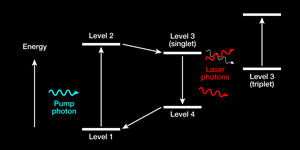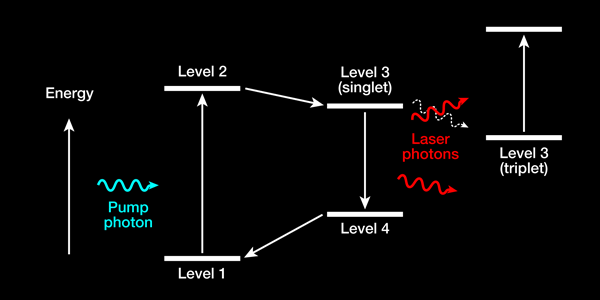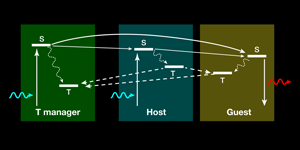Making a Laser Shine Longer
Since their invention just over years ago, lasers have been made in many forms and from many materials. All lasers derive from an insight by Albert Einstein in 1916 [1], when he deduced theoretically the existence of stimulated emission. Stimulated emission is the optical gain process by which electromagnetic waves can stimulate an excited atom or molecule to fall from a higher to a lower energy state and emit more photons of the same frequency, propagating in the same direction as the incident wave. This process, occurring in a population of atoms or molecules excited to the higher energy state, and within a reflective cavity that allows the stimulated emission to build up as it bounces back and forth, results in the emission of light concentrated in a spectacularly sharp line in the frequency spectrum.
The first laser, built in 1960, used a ruby crystal and produced light in a series of pulses [2]. Just a few months later, another group described a different kind of laser, using a mixture of helium and neon as the active medium and producing a continuous beam [3] (see also 10 December 2010 Focus Story). Continuous wave (CW) output is desirable for many laser applications, but operating in this mode can present difficulties. In CW operation, the lasing medium must be continuously pumped to excite the higher energy level, even as stimulated emission is de-exciting that state to the lower level. The balance of pump power against gain saturation and cavity losses produces an equilibrium value of the laser power inside the cavity. Unfortunately, this often requires pumping at a very high continuous power level, which can damage the laser medium by producing excessive heat. Writing in Physical Review B, Yifan Zhang and Stephen R. Forrest of the University of Michigan, Ann Arbor, have taken an important step toward solving these problems in one lasing medium. They explain how CW operation can, in principle, be achieved in an organic semiconductor laser, a type of device until now capable of operating only in pulsed mode [4].
Organic semiconductors are relatives of organic dyes that, in liquid form, have been used as laser media for many years. The wide gain spectrum of available dyes, or mixtures of dyes, allows these lasers to be operated at a range of different wavelengths, or to produce very short-duration pulses. Organic semiconductors, solid thin films of conjugated compounds chemically similar to dyes, are a promising class of materials for lasing applications [5,6]. As they are solid films, they have a high density of chromophores, or color centers. The films also have unusually strong cross sections for optical absorption and stimulated emission. Often, the emission spectrum in these materials is shifted significantly in wavelength from the absorption spectrum, minimizing self-absorption of the laser emission by the material itself. This also means that pumping can occur at a different wavelength than the lasing wavelength, providing a simple method for achieving the population inversion (see Fig. 1 for a schematic level diagram of a typical -level laser). In principle, therefore, optical pumping of organic semiconductors should make CW operation possible. Until now, however, there have been no reports of CW operation in these materials.
Difficulties arise because of the structure of excited levels in organic semiconductors. Conjugated compounds generally have a singlet (spin ) ground state. Selection rules for transitions between levels then imply that only singlet excited states can efficiently emit radiation. But in general the molecules will also have triplet (spin ) excited states that do not contribute to the desired radiation. Because the triplet excited states cannot de-excite as readily as the singlet states, they have long lifetimes, and their population builds up with time as the lasing material is pumped. The high triplet population hinders laser operation in two ways. First, it represents pump energy that has been diverted into excitations that do not contribute to laser output. Second, the triplet state can absorb photons emitted from the singlet state by exciting to a still higher level, thereby directly absorbing laser output (see Fig. 1); the complex structures of organic molecules makes it virtually certain that a higher state positioned to absorb the laser photons will exist. These losses ultimately shut down lasing and prevent CW operation.
Building on prior work [7], Zhang and Forrest show how to resolve these problems by means of what they call a “triplet manager.” Their lasing medium consists of a solid mixture of three organic conjugated molecules: (i) an organic semiconductor host, (ii) the light-emitting guest that determines the laser wavelength, and (iii) an additional molecule serving as the triplet manager (see Fig. 2). The host and guest molecules combine to provide a conventional -level laser system, as in Fig. 1: the singlet excited state of the host feeds the singlet state of the guest. Both molecules, however, also have excited triplet states, which in conventional designs would become populated and close down the lasing system. Adding the triplet manager, however, alters the population balance among these states. The triplet manager is carefully chosen to have a singlet state higher in energy than those of the host and guest, while its triplet state is lower. Pumping excites the manager singlet state, which then acts as an additional mechanism to excite the guest singlet state. More important, the guest and host triplet states transfer their energy to the manager triplet state, which removes them from the lasing system and prevents them from absorbing photons emitted from the guest singlet state, which form the desired laser output. Provided that the manager triplet state is arranged so that it does not overlap with and therefore absorb the guest singlet emission, the loss mechanisms described above will be mitigated.
By means of the triplet manager, Zhang and Forrest achieve a tenfold increase in lasing time: the laser emits continuously for microseconds, or even up to 100 microseconds in some cases. Although the lasers do not operate indefinitely, and thus do not demonstrate true CW operation, Zhang and Forrest argue, using a model treatment of their system, that CW operation would be possible were it not for film degradation due to the high pump power deposited into the soft organic layers. A different choice of triplet manager, with energy levels more closely tuned to those of the guest and host molecules, should also make CW operation easier to attain.
References
- A. Einstein, Verhandlungen der Deutschen Physikalischen Gesellschaft 18, 318 (1916)
- T. Maiman, Nature 187, 493 (1960)
- A. Javan, W. R. Bennet, Jr., and D. R. Herriot, Phys. Rev. Lett. 6, 106 (1961)
- Y. Zhang and S. R. Forrest, Phys. Rev. B 84, 241301 (2011)
- F. Hide, M. A. Diaz Garcia, B. J. Schwartz, M. R. Andersson, Q. B. Pei, and A. J. Heeger, Science 273, 1833 (1996)
- V. G. Kozlov, V. Bulovic, P. E. Burrows, and S. R. Forrest, Nature 389, 362 (1997)
- S. Schols, A. Kadashchuk, P. Heremans, A. Helfer, and U. Scherf, ChemPhysChem 10, 1071 (2009)







